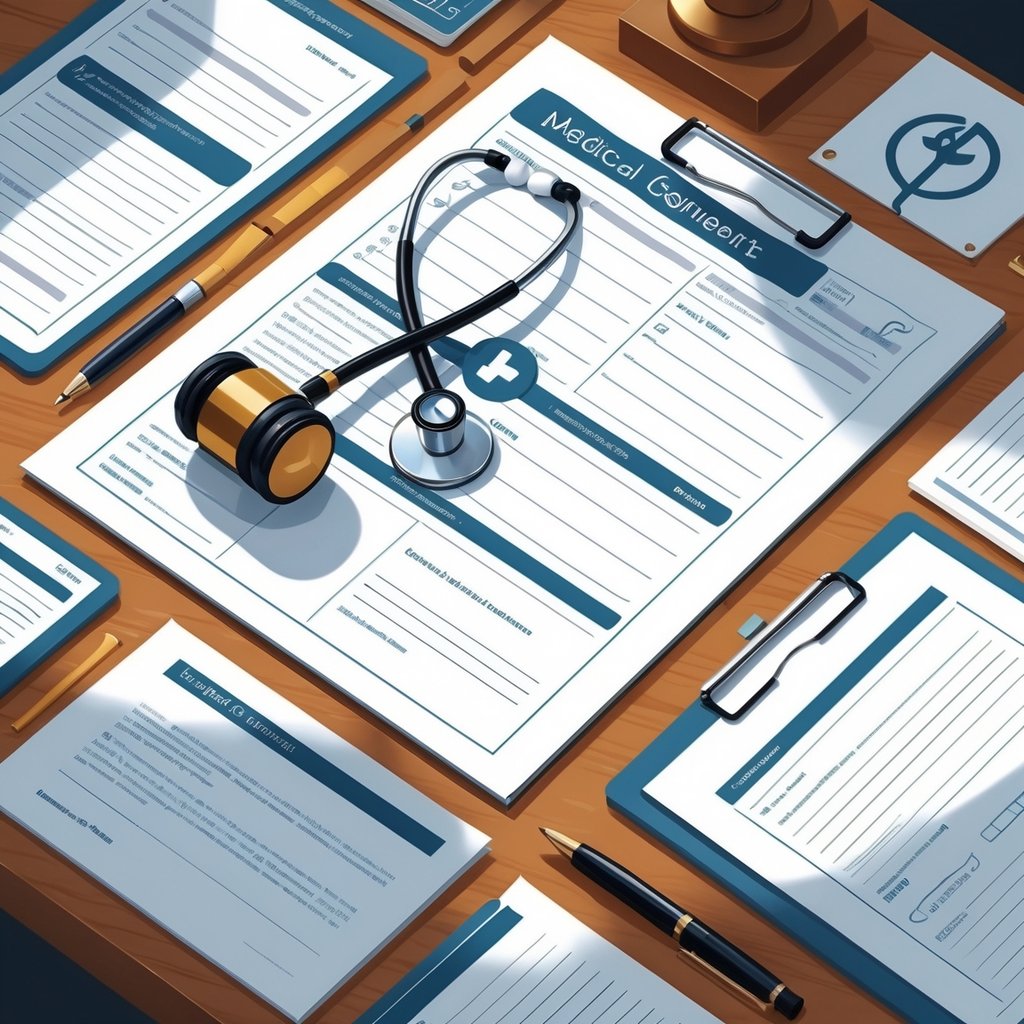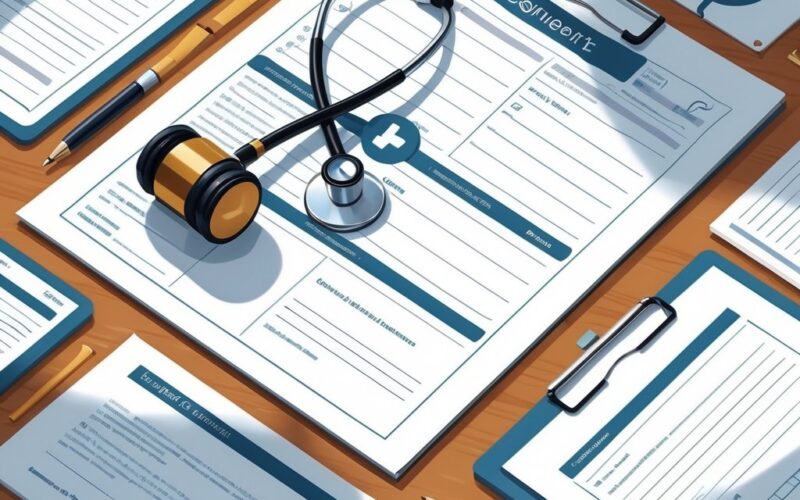Medical legal documents play a big role in healthcare. They protect patients and providers and help guide important care decisions.
These documents cover everything from the consent forms you sign before treatment to advance directives that speak for you when you can’t.

Medical legal documents include consent forms, advance directives, medical records, powers of attorney for healthcare, and certificates that serve as proof of your health status or choices. Each one has a specific job in the healthcare system and carries legal weight when necessary.
Understanding these documents helps you make better decisions about your care. If you need to access your medical records for legal proceedings, or you want your wishes followed during a medical emergency, knowing which documents matter can really change your experience and protection.
Key Takeaways
- Medical legal documents protect your rights and make sure your healthcare wishes are recognized
- They matter most during emergencies, legal fights, or when you can’t decide for yourself
- Filling out these forms properly helps you stay in charge of your care and legal outcomes
Understanding Medical Legal Documents

Medical legal documents serve as both medical records and legal evidence. They protect everyone involved and make sure care gets documented the right way.
Definition and Purpose
Medical documents are legal documents that hold the info needed for safe patient care. They act as your official healthcare history and legal proof of what happened.
Your medical records matter for insurance claims and legal disputes. They show what treatments you got and when.
Healthcare professionals use these documents to communicate with each other. This keeps your care consistent, even if you see different doctors.
Key purposes include:
- Recording your care history
- Supporting insurance reimbursement
- Meeting regulatory rules
- Protecting against legal claims
Clinical vs Non-Clinical Documents
Clinical documents are all about your care and treatment. They include medical histories, progress notes, test results, and treatment plans created during your visits.
Non-clinical documents include contracts, leases, medical insurance forms, and more. These support the business side of healthcare but don’t directly relate to your treatment.
Clinical documents:
- Patient charts and medical histories
- Lab and diagnostic test results
- Prescription and medication lists
- Surgical reports and procedure notes
Non-clinical documents:
- Insurance forms and billing records
- Consent forms and privacy agreements
- Employment contracts for staff
- Facility licensing and compliance paperwork
Both types need careful handling. Clinical documents need strong privacy protection. Non-clinical documents must meet business and legal standards.
Legal Implications in Healthcare
Medical records gain legal standing in court, insurance disputes, or investigations. Your documentation can become evidence that shapes the outcome.
Healthcare providers must document accurately. Missing or wrong records can lead to malpractice claims, penalties, or even losing a license.
You have rights over your medical records. You can access them, request corrections, and decide who gets to see your info.
Legal protections include:
- Privacy under HIPAA
- Right to fix errors
- Access to your whole record
- Control over sharing
Incomplete records make it tough to defend care decisions. Your medical practice needs to follow strict standards to keep patients safe and stay legal.
Core Medical Legal Documents

These documents form the backbone of patient care records and serve as evidence in healthcare settings. They track your journey from symptoms to diagnosis, treatment, and discharge.
Medical Records and Patient Charts
Medical records are the complete collection of your health info gathered during medical care. These include histories, exam findings, and notes from every visit.
Patient charts hold details about symptoms, diagnoses, and ongoing issues. Healthcare professionals log every visit, procedure, and medication change.
Medical history records lay the groundwork for all future care. They include:
- Past illnesses and surgeries
- Current meds and allergies
- Family health history
- Social and lifestyle factors
These records can become legal documents in court, insurance claims, or investigations. Patient care documentation must be accurate to protect everyone.
Diagnostic and Laboratory Reports
Diagnostic test results give solid evidence of your health status. Lab reports show measurements, values, and findings that guide doctors’ choices.
Lab reports cover blood work, urine tests, imaging, and more. They list normal and abnormal values with reference ranges.
Key parts of diagnostic reports:
- Test methods and equipment
- Results with units
- Notes from specialists
- Suggestions for follow-up
Providers rely on these reports to confirm diagnoses and track treatments. Their legal importance jumps when results play a role in major decisions or court cases.
Progress Notes and Treatment Plans
Progress notes track your care and response to treatment over time. Providers record changes in symptoms, medications, and outcomes at each visit.
Treatment plans list the specific interventions and therapies for your condition. These documents show the reasoning behind medical decisions.
Progress documentation includes:
- Your complaints and symptoms
- What the provider finds
- Assessment of your condition
- Plan for next steps
Treatment plans need regular updates as your health changes. Medical record documentation needs to stay consistent and complete to hold up legally.
Discharge Summaries and Care Plans
Discharge summaries wrap up your hospital stay or treatment episode. They help transition you from inpatient care to follow-up with other providers.
Your summary lists admission diagnosis, procedures, medications, and instructions for what comes next. This info keeps your care on track as you move between settings.
Essential discharge elements:
- Main and additional diagnoses
- Procedures and treatments
- Medication list with instructions
- Follow-up appointments
Care plans go further, laying out long-term management for your health. They specify treatments, monitoring, and education you’ll need to stay well.
Consent and Authorization Forms

Healthcare consent forms are legal agreements between you and your provider. They protect both sides and help meet privacy laws.
General Consent Forms
General consent forms create the basic agreement for routine care. They usually cover standard stuff like exams, labs, and basic treatments.
Key Elements:
- Patient acknowledgment of treatment risks
- Agreement to get care
- Acceptance of financial responsibility
- Emergency contact info
Medical consent forms ensure patients understand what’s happening before treatment. You’ll sign these at your first visit to a new provider.
The forms must clearly lay out what care you’re agreeing to. They also state your rights under the law.
Most general consent forms stay valid for ongoing care at the same place. Sometimes you’ll need to sign new ones each year or if policies change.
Release of Information Forms
Release of information forms control how your protected health info (PHI) gets shared under HIPAA. You have to give written permission before providers can share your records.
These forms say exactly what info can be released and who gets it. You decide if you want to share lab results, mental health records, or your whole file.
Common Recipients:
- Insurance companies
- Other providers
- Family members
- Legal reps
Medical release forms allow patients to disclose health information to people or organizations they choose. Each form needs expiration dates and a clear reason for sharing.
You can cancel these permissions in writing anytime. But once info is shared legally, it can’t be taken back.
Special Procedures and Research Consents
Special procedure consent forms give details about complex treatments, surgeries, or experimental care. They go beyond general consent and address specific risks and choices.
Informed consent forms ensure patients grasp the implications of big decisions. You’ll get thorough explanations of benefits, risks, and alternatives before signing.
What’s Required:
- Detailed description of the procedure
- Possible complications and risks
- Other treatment options
- Expected recovery
Research consent forms get even stricter for clinical trials. These explain experimental treatments and the unknowns clearly.
Research study consent forms demonstrate experimental uncertainty in trials and research. You need to know that results aren’t guaranteed.
Privacy laws give extra protection to research participants. Your PHI gets special safeguards during studies.
Advance Directives and End-of-Life Legal Documents

These documents make sure your medical wishes are followed if you can’t communicate. They include instructions for life-sustaining treatments, organ donation, and naming someone to make healthcare decisions for you.
Advance Directives Overview
Advance directives are legal documents that state your treatment preferences if you can’t speak for yourself. They guide doctors and family during tough moments.
Most advance directives have two main parts. One lists your treatment choices. The other names someone to decide for you.
Each state has its own form and rules. You have to be over 18 and mentally able to complete them. Most states want witnesses or notarization but you don’t need a lawyer.
These documents only kick in when you can’t make decisions. Your chosen agent has legal authority to talk with doctors and make choices based on what you wrote.
Living Wills and Healthcare Surrogates
A living will is part of your advance directive. It spells out which medical treatments you want or refuse.
It covers things like feeding tubes, breathing machines, and pain medication during serious illness.
Common living will decisions include:
- CPR and resuscitation preferences
- Mechanical ventilation and breathing machines
- Artificial nutrition through feeding tubes
- Dialysis treatment
- Comfort care and pain management
Your healthcare surrogate is the person you pick to make medical decisions if you can’t. People also call this person a healthcare agent, proxy, or power of attorney.
Choose someone who really gets your values and can handle tough calls. It’s easier if they live close and can be there quickly in emergencies.
Talk through your wishes with them before signing anything.
Your healthcare surrogate has legal authority that doctors must respect. They can check your medical records, talk with your care team, and make treatment calls based on what you’ve written.
Do Not Resuscitate Orders (DNR) and POLST
A do not resuscitate order is a medical order your doctor writes. It tells healthcare teams and EMTs not to perform CPR if your heart or breathing stops.
DNR orders need a doctor’s signature. Emergency medical technicians must honor DNR orders in hospitals and at home.
POLST stands for Physician Orders for Life Sustaining Treatment. These forms go beyond DNRs and cover several treatment choices for seriously ill patients.
POLST forms typically address:
| Treatment Type | Options Available |
|---|---|
| Resuscitation | Full CPR or do not resuscitate |
| Medical interventions | Full treatment, limited treatment, or comfort care |
| Feeding tubes | Artificial nutrition or no tube feeding |
| Antibiotics | Use antibiotics or focus on comfort |
POLST forms are state-specific and made for people with serious health conditions. Your doctor helps fill them out based on your health and prognosis.
Organ Donation and End-of-Life Planning
People often include organ donation choices in advance directives or use separate registries. You can decide which organs or tissues you want to donate after death.
Most states let you add donation wishes to your driver’s license. You can also register online with your state’s donor registry.
These registrations are legally binding and override family objections.
Donation options include:
- All organs and tissues
- Specific organs only (heart, liver, kidneys)
- Tissues only (corneas, skin, bone)
- Body donation for medical research
Talk about your donation wishes with family and your healthcare surrogate. Put these choices in your advance directive so they’re on record with your other medical instructions.
Getting your legal documents organized before a medical emergency helps make sure your wishes are followed. Keep copies where you can find them and give them to your surrogate and main doctor.
Powers of Attorney and Legal Representatives

A durable power of attorney for healthcare lets someone make medical decisions if you can’t. Healthcare proxies and agents step in as your chosen representatives with authority to talk to medical teams.
Durable Power of Attorney for Healthcare
A durable power of attorney for healthcare lets you pick someone you trust to make medical decisions if you can’t speak for yourself. This document keeps working even if you lose mental capacity.
Your agent can see your medical records and approve treatments. They work with healthcare providers to follow your wishes.
The agent can’t override your choices if you’re able to communicate.
Key Powers Include:
- Consenting to or refusing medical procedures
- Choosing healthcare providers
- Accessing medical records
- Making decisions about life support
This legal form must fit your state’s rules. Most states want witnesses or a notary. The document stays active until you cancel it or pass away.
General Power of Attorney
A general power of attorney covers legal and financial matters outside healthcare. Usually, it doesn’t give medical decision rights unless you say so.
General power of attorney forms handle money and legal affairs. They don’t let your agent access medical records or talk to doctors unless you add that power.
Healthcare providers often want a separate medical power of attorney.
Financial Powers May Include:
- Banking transactions
- Property management
- Insurance claims
- Legal proceedings
You need both financial and medical power of attorney documents to cover all bases. Each serves a different purpose and follows its own legal rules.
Healthcare Proxy and Agent Designations
Healthcare proxy and agent designations are names for the person you choose to make medical decisions. States use different terms for the same job.
Common Terms Include:
- Healthcare agent
- Medical proxy
- Patient advocate
- Healthcare surrogate
- Attorney in fact
Your chosen representative gets full access to medical records. They can talk to doctors and receive protected health information.
Pick someone who understands your values and can make hard choices. Go over your medical preferences with them before signing anything. Make sure they know where to find your documents.
Additional Supporting Medical Legal Documents

These documents help prove what happened in legal cases. They show treatment decisions, procedures, and patient care beyond basic records.
You’ll find details about medications, imaging, surgeries, and admin communications that can support or challenge medical claims.
Prescriptions and Medication Records
Your prescription records prove what medications your doctor ordered and when you got them.
Key Components of Prescription Records:
- Medication name and strength
- Dosage instructions
- Prescribing physician information
- Pharmacy dispensing records
- Refill history and dates
Medication records track how you respond to treatments. They show side effects, dosage changes, and if the treatment worked.
These records matter in malpractice cases involving wrong meds or dosing mistakes.
Your pharmacy records show if you actually filled prescriptions and took meds as directed. This info can back up or challenge claims about following treatment.
Imaging and Radiology Reports
Your X rays, MRIs, and other scans give solid evidence of medical issues. Radiology reports explain what the images show and help guide diagnosis and treatment.
Types of Imaging Records:
- X rays – Show bone breaks, lung problems
- MRIs – Reveal soft tissue injuries, brain issues
- CT scans – Document internal injuries, organ damage
- Ultrasounds – Track pregnancy, organ function
Imaging reports include technical details and the radiologist’s take on what they see. These reports often become important in personal injury or malpractice cases.
Your imaging records show how injuries or diseases change over time. Comparing images from different dates can prove when something started or got worse.
Operative and Surgical Reports
Operative reports explain what happened during surgery. They include details about the procedure, any problems, and care decisions afterward.
Standard Operative Report Elements:
- Pre operative diagnosis
- Surgical procedure performed
- Surgeon and team members
- Complications encountered
- Post operative condition
These reports matter when surgical outcomes are questioned. They show if the right techniques were used and how complications were handled.
Surgical progress notes track your recovery. They include pain levels, wound healing, and any post op problems.
This info can help connect surgery to later medical issues.
Operative reports also list medical devices used during surgery. That detail matters if device failures cause bad results.
Patient Information Leaflets and Administrative Records
Patient information leaflets (PIL) show what you were told about treatments and risks. Administrative records prove you got the info needed to make choices.
Important Administrative Documents:
- Consent forms and signatures
- Patient education materials
- Appointment scheduling records
- Insurance authorization forms
- Medical services billing records
Your PIL records prove what you learned before procedures. They show if doctors explained risks, options, and what to expect.
Administrative records track your access to care. They show appointment times, cancellations, and any delays.
Billing records back up what services you received. They list dates, procedures, and providers.
Legal Compliance and Retrieval in Medical Documentation

Retrieving medical records means following strict privacy laws and state rules. Healthcare providers need to protect your privacy while giving proper access to documents.
Accessing and Retrieving Medical Records
You need the right paperwork before retrieving medical records for litigation or other legal reasons. Most facilities want written consent from the patient or a valid court order.
Authorization Requirements:
- Patient consent forms
- Court subpoenas
- Legal guardian approval
- Power of attorney documents
Electronic health records (EHRs) make access faster but sometimes more complicated. You should work with people who know about different medical document types and storage.
Many places use specialized retrieval services. These handle both electronic and paper records while keeping things secure.
Retrieval Process Steps:
- Submit proper authorization
- Verify identity and legal standing
- Specify exact records needed
- Pay applicable fees
- Receive records through secure transmission
Processing times range from a few days to a few weeks, depending on the records and the facility.
Legal Standards and State Laws
Every state sets its own rules for medical record access and retention. You have to know legal standards for medical documentation where you live.
Common State Requirements:
- Minimum retention periods (often 7 to 10 years)
- Patient access timelines (usually 30 days)
- Fee structures for copies
- Authentication procedures
Federal laws also apply. Medicare needs specific documentation for billing and coverage.
Some states have extra rules for sensitive records like mental health or substance abuse. You might need more authorizations for those.
Key Compliance Areas:
- Record completeness and accuracy
- Timely documentation requirements
- Proper authentication signatures
- Amendment procedures
Legal teams often work with medical records management partners to stay compliant in different states.
Protecting Patient Privacy and HIPAA Compliance
HIPAA sets the baseline for medical record privacy. You must stick to strict protocols when handling protected health information.
HIPAA Requirements:
- Minimum necessary rule – only access what you need for your purpose
- Secure transmission – use encrypted methods for electronic transfers
- Access logging – keep audit trails of who accessed records
- Business associate agreements – contracts with third party services
Patient privacy goes beyond just HIPAA. You need more safeguards during retrieval.
Privacy Protection Measures:
- Secure storage of records
- Only let authorized people see them
- Proper disposal of sensitive documents
- Regular staff security training
Medical record retrieval professionals use strong encryption and secure transmission. This helps stop unauthorized access.
Violations bring big penalties. HIPAA fines can reach thousands or even millions depending on what happened.
Frequently Asked Questions
Medical legal documents have specific requirements for consent forms, release forms, and advance directives. Knowing the difference between living wills and healthcare powers of attorney helps ensure proper legal protection.
What are the essential components of a medical consent form?
A medical consent form needs your name, date of birth, and medical record number for identification. It should describe the treatment or procedure in clear terms.
Your doctor explains the risks, benefits, and possible complications of the treatment. The form also lists other treatment options you can consider.
There should be space for your questions and answers before you sign. You, a witness, and the date all need to appear for the document to be valid.
How does a living will differ from a healthcare power of attorney?
A living will tells doctors which medical treatments you want or refuse if you can’t speak for yourself. It focuses on things like life support, feeding tubes, and resuscitation.
A healthcare power of attorney lets someone else make medical decisions for you when you can’t. This person can decide about any medical situation that comes up.
A living will only applies in certain situations. A healthcare power of attorney covers all types of medical care.
What is the purpose of a HIPAA release form?
HIPAA release forms let you share your medical information with specific people or organizations. Without it, doctors won’t discuss your health details with family or other providers.
You decide who can see your records and what they’re allowed to view. The form lets you pick which parts of your medical history to share.
Insurance companies, employers, or other doctors usually need this form to review your medical information. You can change or cancel these permissions anytime.
In medical malpractice cases, what types of documents are typically required?
You’ll need your full medical records from all providers involved in your care. This means doctor visits, hospital stays, test results, and treatment notes.
Keep copies of bills, insurance claims, and payment records related to your treatment. These show the financial side of your care.
Expert medical opinions and reports help explain where care fell short. Letters or emails between you and your providers can matter a lot, too.
What information needs to be included in a medical records release form?
Your full name, date of birth, and contact info should be on the form. Clearly state which records you want released.
Name the person or organization who will get your records. Add dates or time periods for the information you’re sharing.
You need to sign and date the form to make it legal. The form should mention when the authorization ends or how you can cancel it.
What are the legal requirements for an advance directive?
You need to be at least 18 and mentally capable when you make your advance directive. The document has to be signed and dated with witnesses or a notary public present.
Most states ask for two adult witnesses who aren’t related to you or listed in your will. Some places just let a notary public handle it instead.
Your advance directive should spell out what you want for medical treatment in certain situations. It only kicks in when your doctor says you can’t make your own medical decisions.










